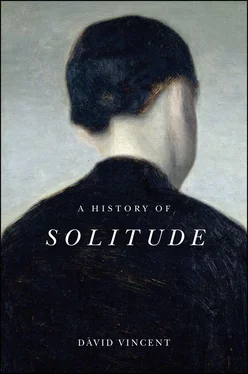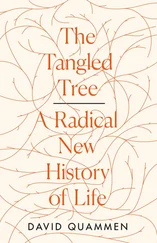The second function of solitary behaviour was as a pathology of modernity. The licentious pursuit of material pleasure and individual satisfaction increasingly threatened healthy forms of sociability. Severe forms of physical or psychological morbidity were a direct, quantifiable measure of unmanageable contradictions in interpersonal relations. Over the period covered by this study, concerns coalesced around the emerging notion of loneliness. Before the modern era, the term was rarely deployed in isolation from emotional solitude more generally. Milton’s 1643 tract on divorce argued that marriage was primarily ‘a remedy against loneliness’, and existed to provide ‘the apt and cheerful conversation of man with woman, to comfort and refresh him against the evil of a solitary life’. 87In the eighteenth century, lonely meant a state or more often a place of solitude. It began to appear more widely as a distinct negative emotion in the writings of the Romantic poets. 88The disaffected wandering of Byron’s Childe Harold takes him to the Alps, ‘The palaces of Nature, whose vast walls, / Have pinnacled in clouds their snowy scalps, /And throned Eternity in icy halls / of cold sublimity.’ 89There was, however, ‘too much of man’ in Lac Leman and he renewed his quest for a form of bitter solitude: ‘soon in me shall Loneliness renew / Thoughts hid, but not less cherish’d than of old.’ 90
The term ‘loneliness’ entered popular discourse during the nineteenth century, although initially the concept was subsumed within the pathologies of solitude discussed by successive medical authorities and other writers. 91In Charles Dickens’s 1840 Christmas story, a deaf, elderly man is befriended on the festive day by the narrator, who seeks to draw him out of his melancholic isolation, described in the story not as loneliness but as a state of ‘solitude’. 92Gradually it became a separate condition, carrying with it a specific set of symptoms. Writing in 1930, G. K. Chesterton satirized the emergence of what appeared to be a particularly local phenomenon:
One of the finer manifestations of an indefatigable patriotism has taken the form of an appeal to the nation on the subject of Loneliness. This complains that the individual is isolated in England, in a sense unknown in most other countries, and demands that something should be done at once to link up all these lonely individuals in a chain of sociability. 93
Loneliness was embraced by the emerging discipline of psychology. 94At its most intense it could cause outbreaks of psychotic illness. The diffuse concept of melancholy was reborn as a condition with interacting mental and physical symptoms. Chapter 7will examine the post-1945 emergence of a public crisis of loneliness, culminating in the appointment of the world’s first government minister for the phenomenon, and the publication of an official strategy to combat it.
The third change was the most pervasive yet the least recognized by contemporary commentators. The replacement of literary doctors by professional social scientists from the late Victorian period onwards did little to alter the marginal status of solitary behaviours. The first major study to place solitude as a normal and necessary aspect of living was written by the psychologist Anthony Storr as late as 1989. He mounted a case against the prevailing orthodoxy. ‘It is widely believed,’ he wrote in his Preface, ‘that interpersonal relationships of an intimate kind are the chief, if not the only, source of human happiness.’ 95His book stimulated greater interest in the topic amongst social scientists, but as recently as 2016, Ira Cohen could still observe that ‘while my fellow sociologists have made extraordinary progress in the study of how individuals engage in social interaction, they have seldom acknowledged that there is an entire realm of behaviors in which people engage when they are not involved in interpersonal encounters’. 96Such activities, it will be argued in this history, were more than residual pastimes that have been obscured by the noise and energy of commercial progress. Rather, they were at once a product of modernity and a necessary condition of its success. From the early nineteenth century onwards, multiform improvements in material prosperity, consumer markets and communication networks made possible a wider range of solitary practices across the population. Solitude in its basic form as a site of fleeting leisure amidst hard-pressed lives became more available, especially for women and the labouring poor. It will be argued, particularly in Chapters 3and 5, that at all stages of the life-course, and for all but the most dispossessed of society, these forms of solitary endeavour made a sustainable sociability possible.
The dynamics of change across these three functions have been obscured by a static conception of solitude as an activity. In Zimmermann’s treatise, as more widely in his own time and subsequently, solitude was seen as a simple antonym of physical company. He insisted, as we have seen, that the motives for withdrawal were critical, but nonetheless assumed that in all circumstances he was dealing with the absence of another in a particular space. The modern debate about loneliness is still largely predicated on a binary opposition between face-to-face contact and non-communicative isolation. Whether in an unpeopled landscape or an empty room, the withdrawn figure is a key component of the experience and understanding of solitude throughout our period. Two further forms of solitude have, however, become increasingly significant. The first may be termed networked solitude, the engagement with others through print, correspondence or other media whilst otherwise alone.
In the late eighteenth century, particularly at the level of education and society that a medical practitioner occupied, there was already an intervening structure of virtual representation, whereby an individual could be both by himself or herself and in communication with another. In Britain, men and women of the gentry class had been using letters to conduct their affairs with distant relatives and business partners since the later middle ages. 97By 1800, what Susan Whyman terms ‘epistolary literacy’ had reached as far down as the many literate members of the artisan community. 98For a manual worker, the composition or receipt of a letter was a rare event, but leading scientists had long been accustomed to maintaining a network of correspondents across Europe and latterly with the New World. Zimmermann conducted not only his research on this basis but also his literary endeavours. ‘His work upon Solitude,’ recorded Tissot, ‘was received with great éclat , not only in Germany, but wherever German is read, and procured him a correspondence which gratified him greatly.’ 99The subsequent expansion of European and global postal networks, founded on the flat-rate, pre-paid model of Britain’s 1840 Penny Post, was designed to maintain connections between family members dispersed by the economic and demographic upheavals of the period. 100The later inventions of the telephone and the internet, which will be discussed in the final chapter, supplied further means of managing physical isolation. Networked solitude both reduced the stress and enriched the experience of being alone. Through correspondence and the proliferating forms of printed media, it enabled solitary individuals to enjoy their own company and at the same time feel that they were in some sense part of a wider community.
The second alternative form has only lately become the subject of scholarly discussion. 101Abstracted solitude was the capacity to be alone amidst company. It was the means by which individuals withdrew their attention and thoughts from those in close physical proximity. The long-standing concern with finding mental space within the press of people gained a new urgency in the rapidly expanding metropolitan civilization of the eighteenth century. In 1720, Daniel Defoe wrote a second sequel to his epochal novel of solitude. 102Robinson Crusoe was now back in London, and anxious to draw a distinction between absolute physical isolation, whether chosen or enforced, and a temporary withdrawal from surrounding company. The returned castaway had no nostalgia for his former life. The solitude he had enjoyed was necessary to the wellbeing of his moral self, but artificial and unsafe when disconnected from the moral structures and constraining perspectives of educated society. The most profound forms of spiritual reflection were better undertaken in the midst of everyday activity. ‘Divine Contemplations,’ Crusoe insists, ‘require a Composure of Soul, uninterrupted by any extraordinary Motions or Disorders of the Passions; and this, I say, is much easier to be obtained and enjoy’d in the ordinary Course of Life, than in Monkish Cells and forcible Retreats.’ 103The crowd, specifically that of the nation’s capital, was a condition of disciplined, productive meditation, not its negation:
Читать дальше












